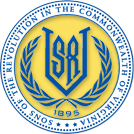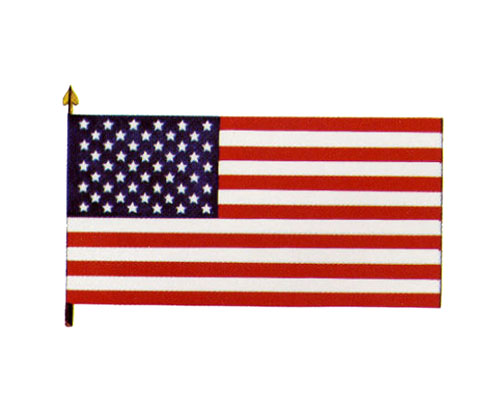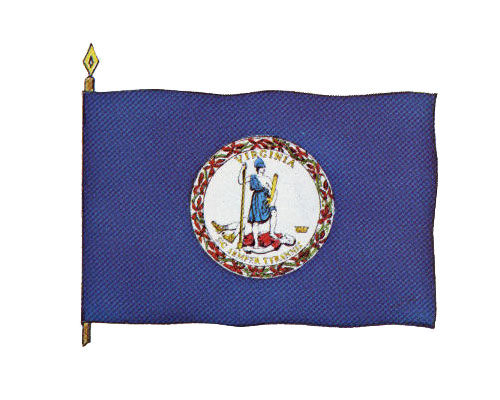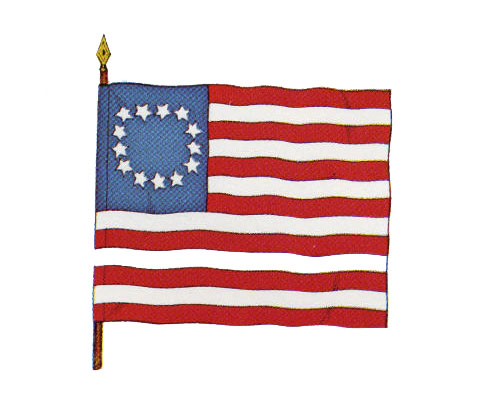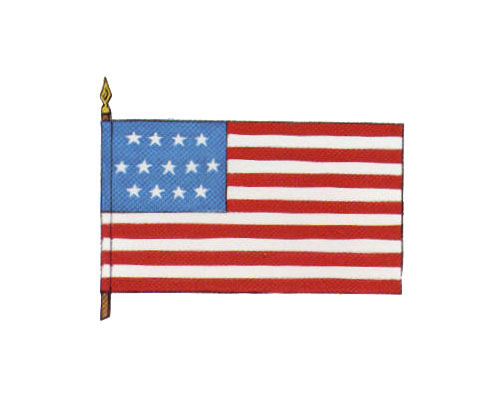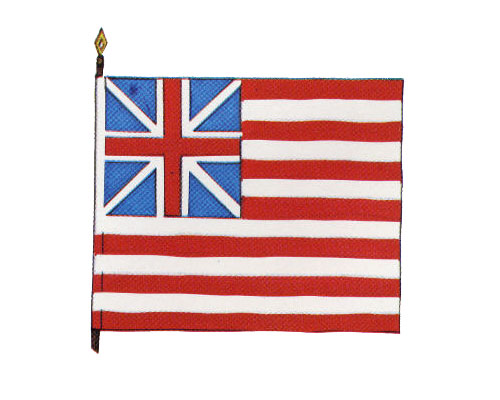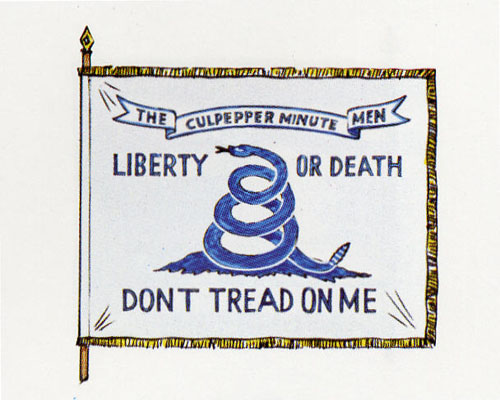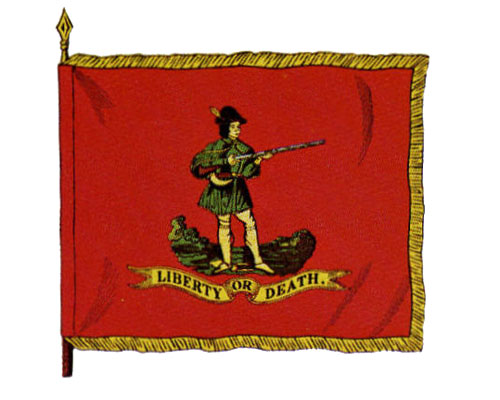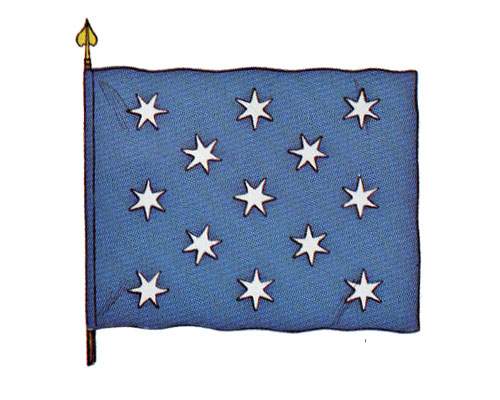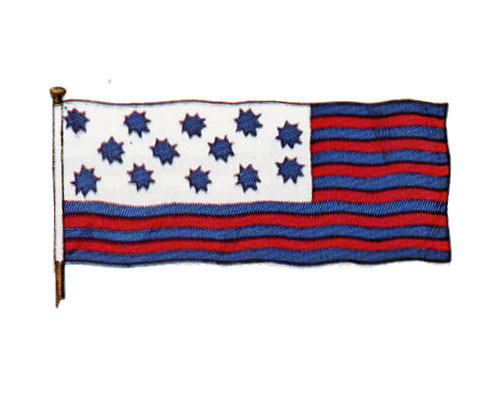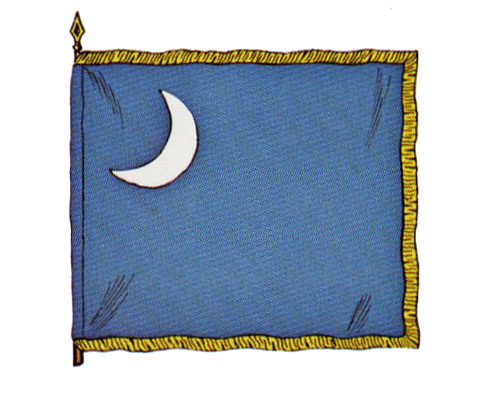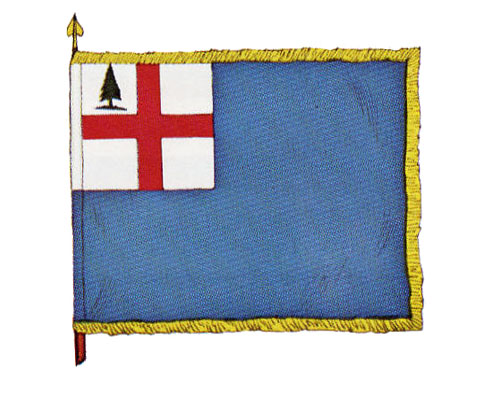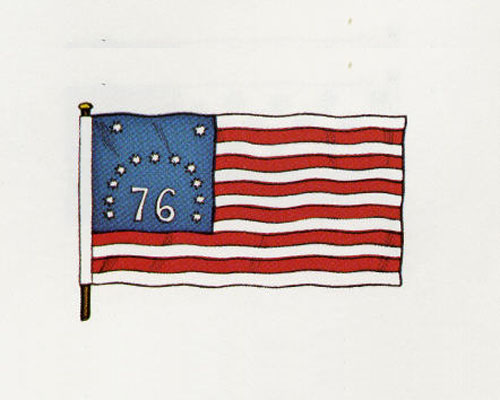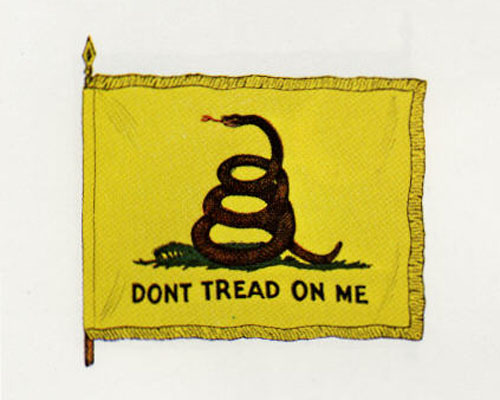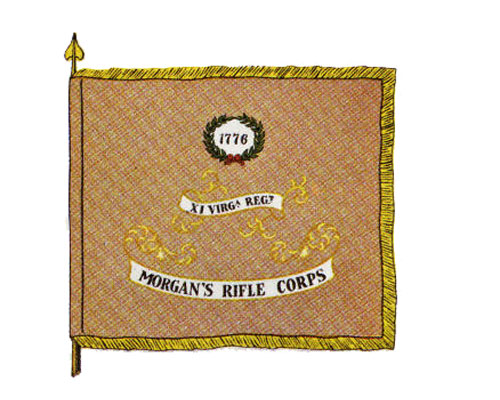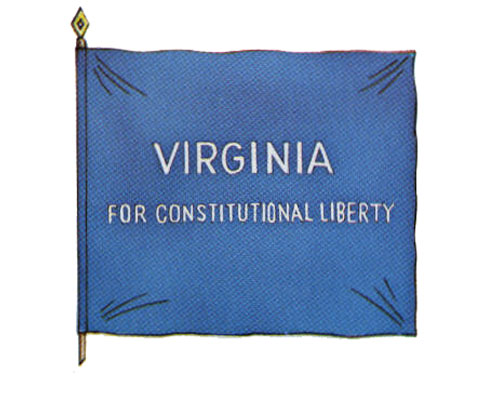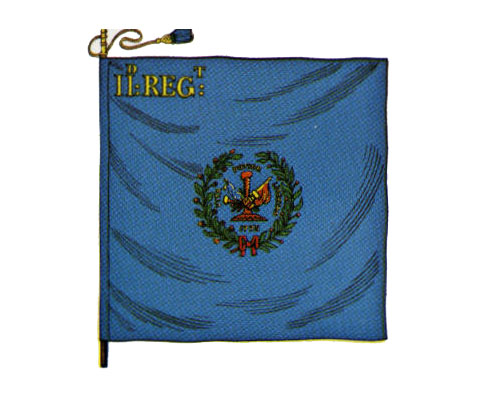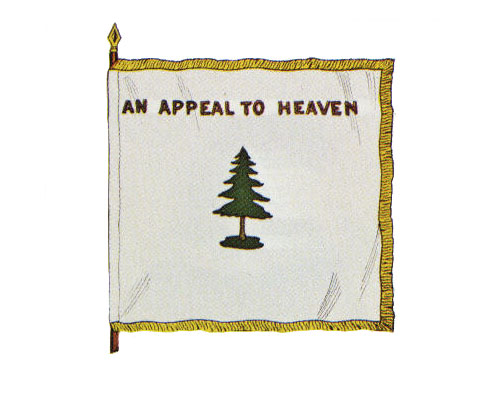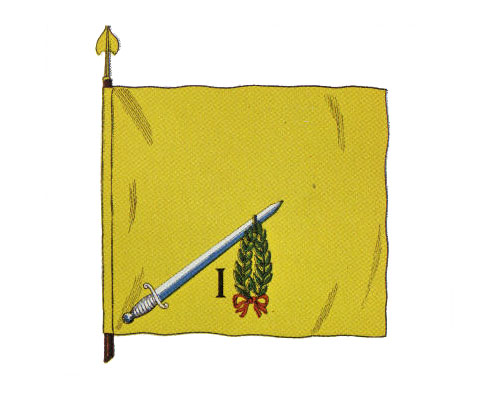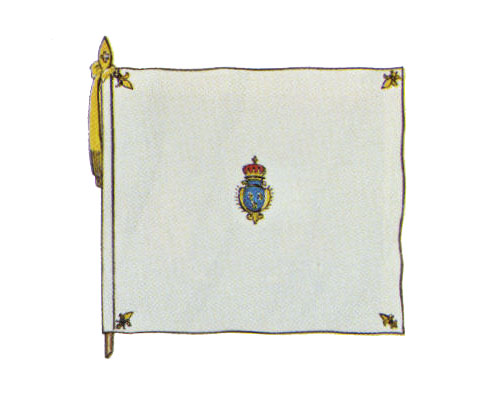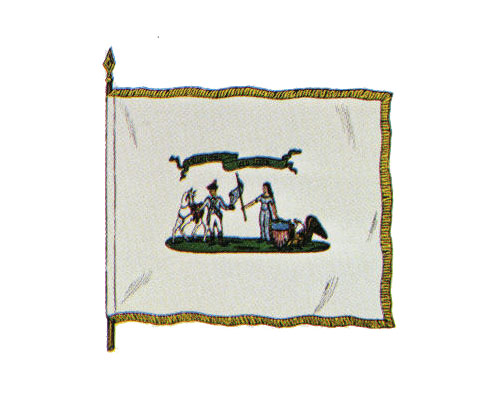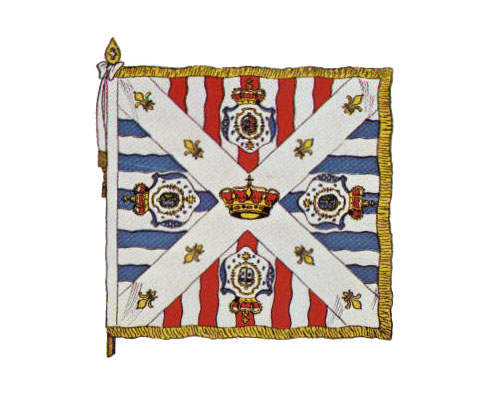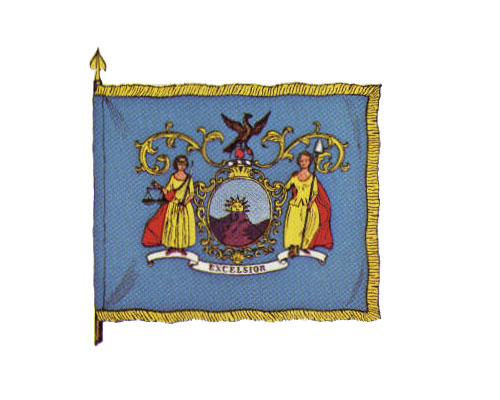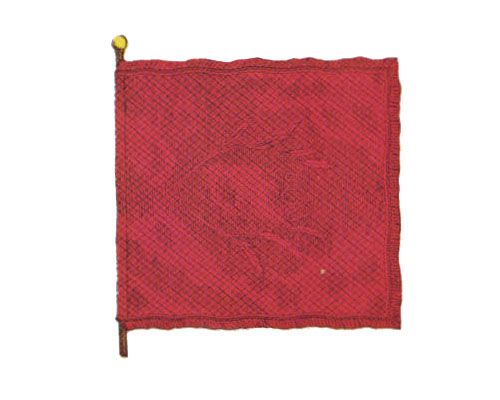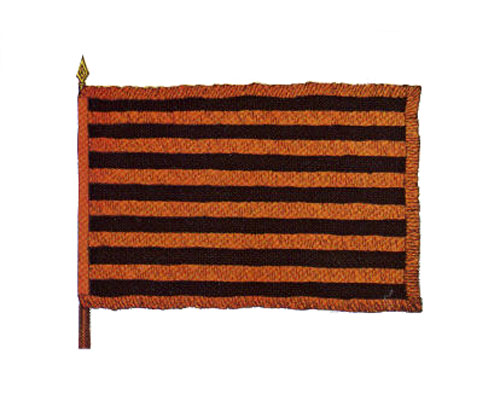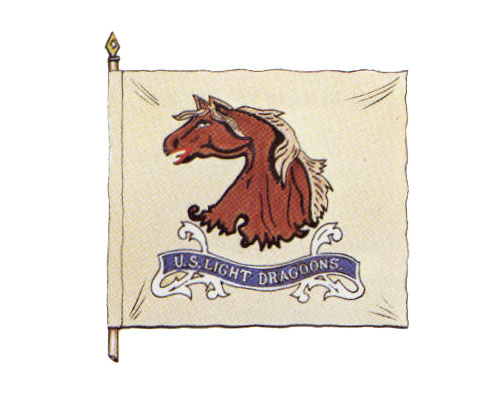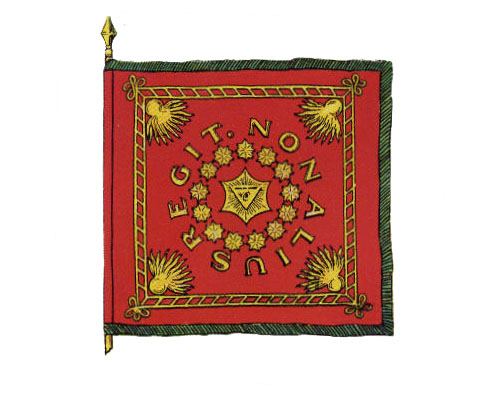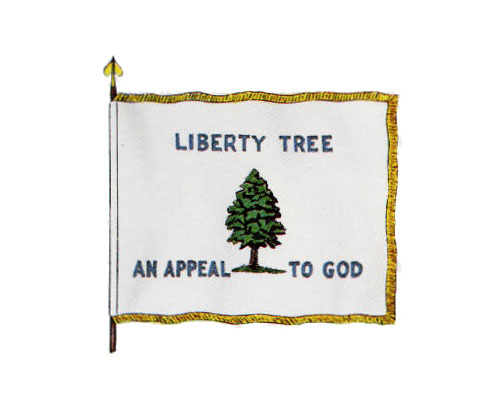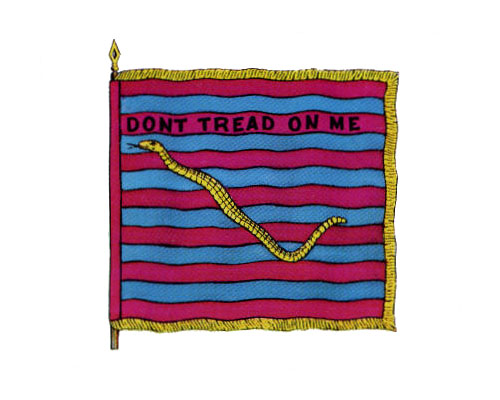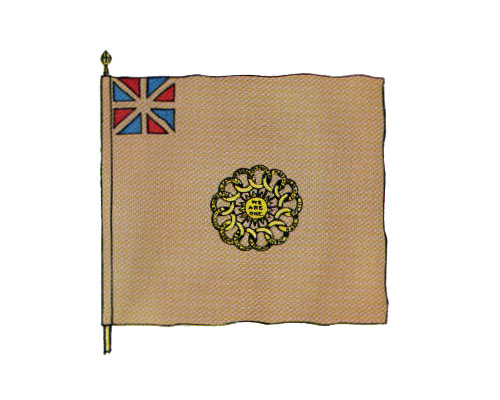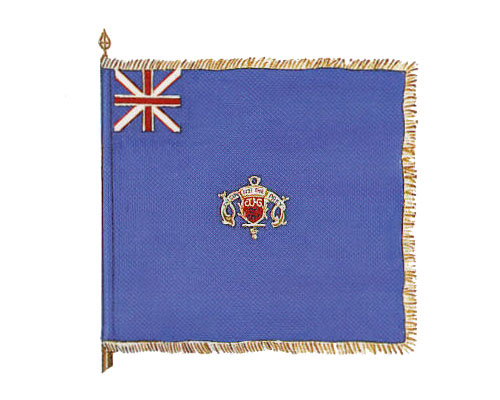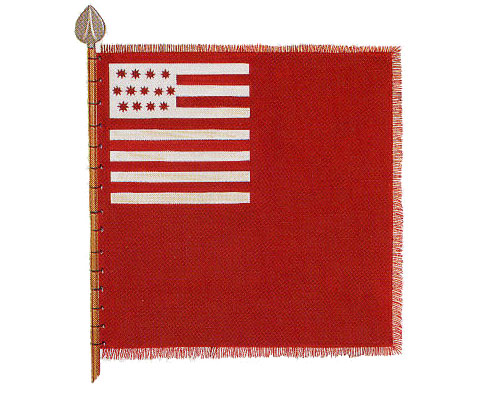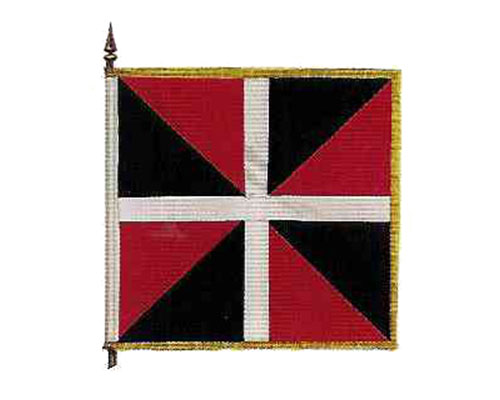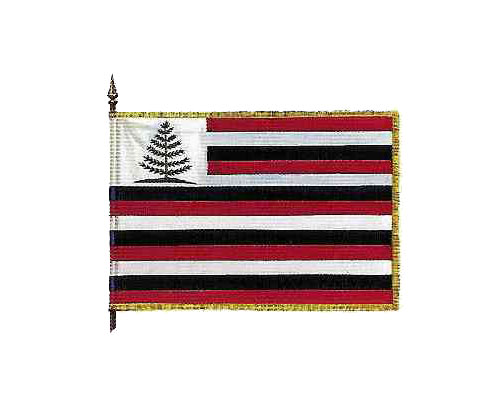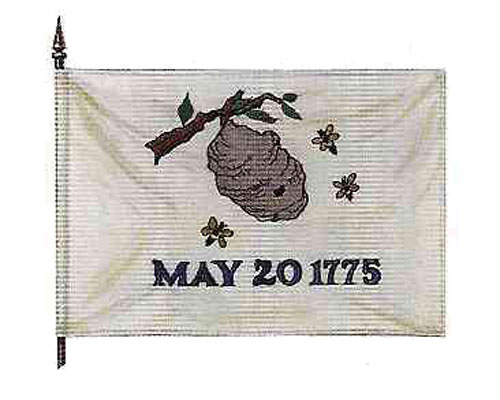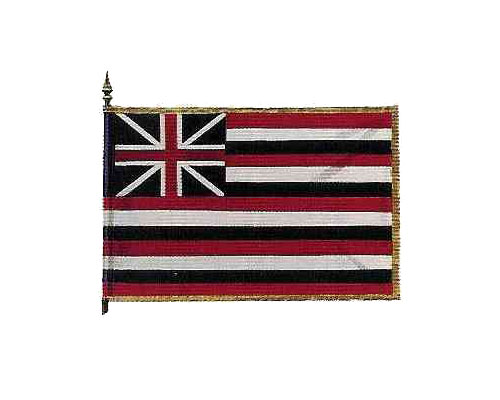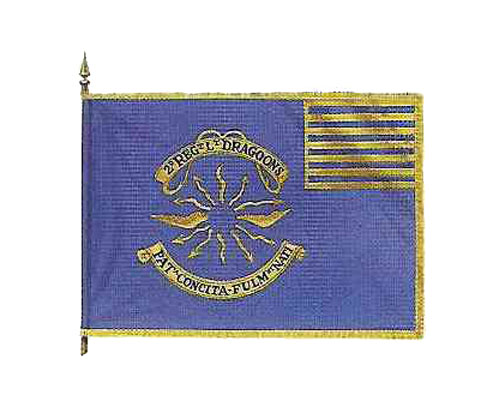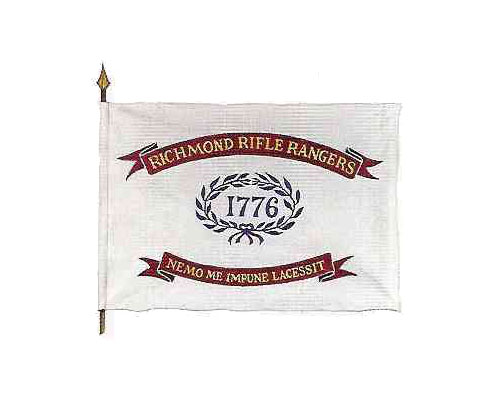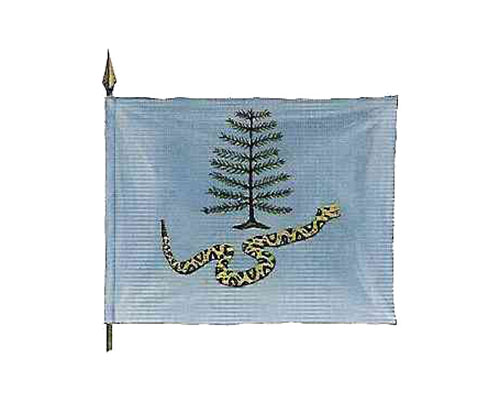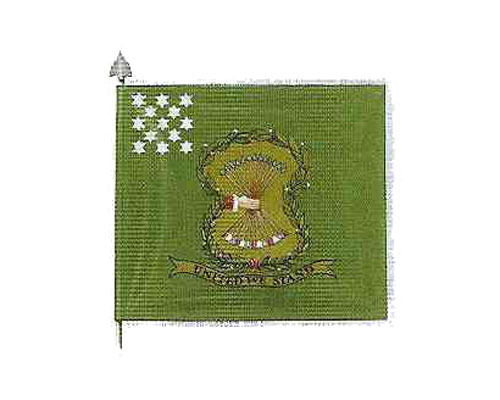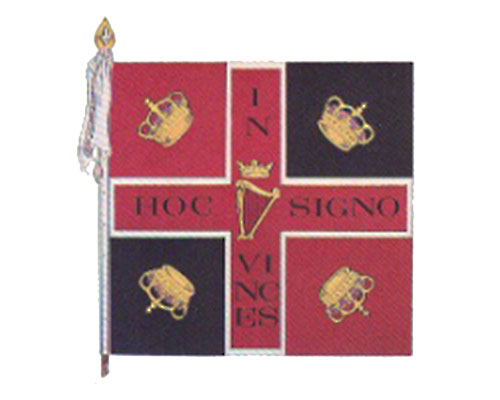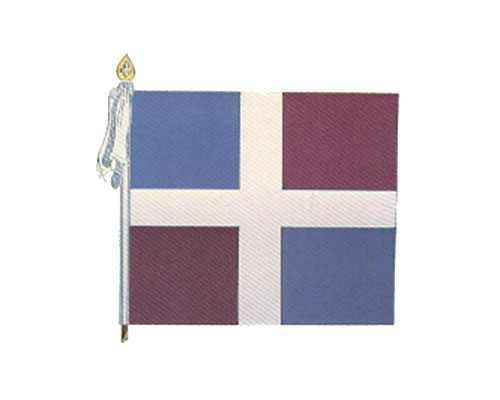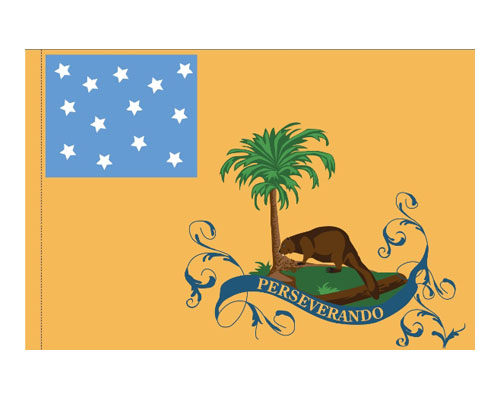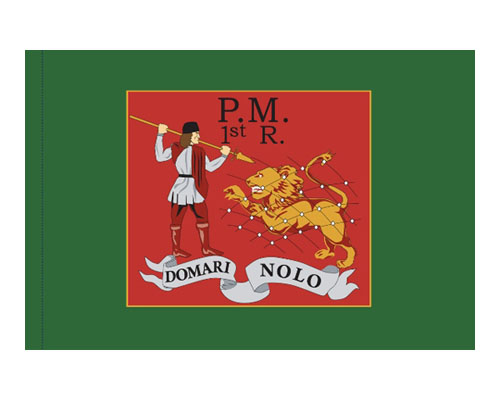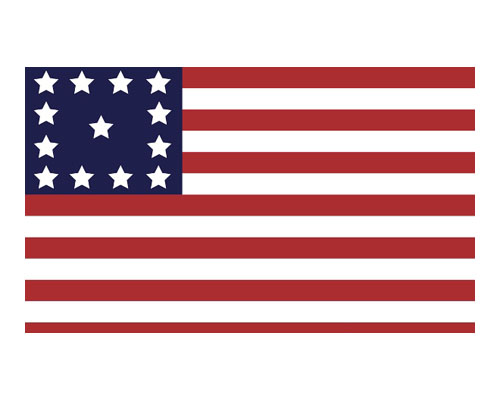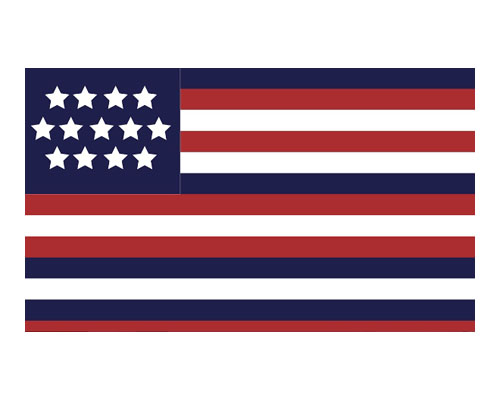Flag of Gatinois Regiment
The Gatinois Regiment took part in the combined French and American assault on the British garrison at Savannah in 1779. The regiment and colors are pictured in Van Blarenberghe’s 1786 painting of the Surrender at Yorktown. Presented by John D. Rockefeller, Jr., an honorary member of the Virginia Society.
French National Flag
The national emblem of the Fifth Republic, the tricolour flag, came about during the French Revolution, by combining the colour of the king (white) with those of Paris (blue and red). Today, the French tricolour can be seen on all public buildings. It is used for most official ceremonies, both civilian and military.
Lafayette’s Continental Light Infantry Corps (2)
Battalion Colors of Lafayette’s Continental Light Infantry Corps as donated by Stephen Atkinson and his son Prescott Atkinson in honor of Private Patton, PA Militia.
1st Virginia Regiment
Flag of the 1st Virginia Regiment as donated by Neal Roper in honor of his brother, Paul “Spot” Roper, III.
Lafayette’s Continental Light Infantry Corps
Battalion Colors of Lafayette’s Continental Light Infantry Corps. Donated by Stephen Atkinson and his son, Prescott Atkinson in honor of Private Patton, PA Militia.
The National Colour
the flag of the United States with 50 stars, including the two representing the most recently added states of Hawaii and Alaska. This flag became official on July 4, 1960. Presented by A. Simpson Williams, Jr., in memory of his uncle, Dr. J. Fulmer Bright.
The Flag of the Commonwealth of Virginia
bearing the State seal with the motto, “Sic Semper Tyrannis” – Thus Always to Tyrants. The seal and the motto adopted in 1776 soon after Virginia declared her independence from Great Britain express this recommendation of a committee consisting of George Mason, Richard Henry Lee, George Wythe, and Robert Carter Nichols. Presented by G. Moffett King, in memory of J. Jordan Leake, a former president of the Virginia Society.
Virginia Society Flag
We have two Flags for the Society of the Sons of the Revolution in the Commonwealth of Virginia. The one on permanent display at the Yorktown National Battlefield Park was donated by George A. Zabriskie. The one on display in Richmond, was donated by friends of McLain T. O’Ferrall.
Betsy Ross Flag
with the stars arranged in a circle. Although often used as a symbol of the American Revolution, This flag was never adopted by Congress. It was used by General Schuyler and the New York Troops. Presented by W. Brydon Tennant.
First Stars and Stripes
the first official flag adopted by Congress, June 14, 1777. First used on the sloop “Ranger”, commanded by John Paul Jones. The Stars follow the canton of the Grand Union flag. Not until 1834 was any regiment of the Army authorized to carry the Stars and Stripes. Presented by Alfred P. Goddin and C. Hobson Goddin in memory of Captain Alfred P. Goddin, Jr., killed in action in the Philippines April 1, 1945.
Continental Flag or Grand Union Flag
displayed January 1, 1776, by General Washington at Cambridge, Massachusetts. The canton is that of the Union of England and Scotland, the crosses of St. George and St. Andrew. The stripes are from the ensign of the East India Company chosen because of the significance of the thirteen colonies. Presented by Frederick P. Wilmer. and T. Wilson Wilmer in memory of their father, Arthur P. Wilmer.
Culpeper Minute Men
The flag of the Battalion Culpeper Minute Men of 1775. This Battalion of 150 wore uniforms of green hunting shirts with the motto “Liberty or Death” across the chest. They were called “The Shirtmen”. They were in the front at the Battle of Great Bridge in November, 1775 against Lord Dunsmore, the last Royal Govenor of Virginia. One volunteer wanted the motto changed to “Liberty Or Be Crippled”. Presented by Joseph Y. Gayle, Dr. R. Finley Gayle, Lester T. Gayle and Kenneth H. Gayle in the memory of their Revolutionary War ancestors, Captain Robert Gayle and William Richardson.
Hanover Flag
The flag of the first Virginia Regiment also known as the “Shirtmen”. One of the flags of the First Virginia Regiment. It was used first by “Shirtmen” of Hanover County, Virginia. Presented in memory of the officers and men of that regiment and one soldier of that regiment who served at Trenton, Princeton, Germantown, Valley Forge, Monmouth and Guilford, by General Edwin Cox, a former president.
Washington’s Headquarters Flag
First flown at Valley Forge and subsequently the Headquarters Flag of the Continental Army. It has 13 stars, wach with six points on a blue field. Presented by William Ronald Cocke III, in memory of his Revolutionary ancestor, Captain Chastain Cocke.
United States Flag
The United States Flag with forty-eight stars. Presented by A. J. Battle, Jr.
Guilford Flag
The flag of the North Carolina Militia carried at Camden, King’s Mountain, Cowpens, Hillsborough, and Guilford against the British. The costly campaign led to the final defeat of Lord Cornwallis. The flag has 13 blue stars, each with eight points, against a white background. It also has blue and red stripes, rather than the usual red and white ones. Presented by Samuel Spencer Jackson and Herbert Worth Jackson, a former president.
Crescent Flag of South Carolina
This Flag was used by troops under the command of Colonel Moultrie at Charleston in 1776. It is the basis of the state flag of South Carolina adopted later. Presented by William Rhodes Thomas, in memory of his Revolutionary War ancestor, Captain Michael Thomas.
Bunker Hill Flag
Is the so-called New England Flag with a pine tree, the New England symbol of liberty, flown at the Battle of Bunker Hill, June 17, 1775. The flag dates back to a pre-revolutionary maritime flag with the addition of the “pine tree”. It has the Red Cross of St. George. Presented by Herbert Worth Jackson, Jr., a former president.
The Bennington Flag
This is the first stars and stripes carried by any land force in battle (Battle of Bennington, Vermont, August 16, 1777) and the first flag to be “raised in victory”. It demonstrates how little concern there was in the first decades of the United States for standardized flag patterns. Presented by Barbour N. and Jane Douthat Thornton, in memory of General Stephen Moylan and Colonel Thomas Barbour, officers of the Revolution.
The Flag of the Continental Navy
The First Continental flag, this colour was used on some of the thirteen ships provided by Congress in 1775. It bore the famous rattlesnake symbol, already seen on the Culpeper Minutemen Flag and the motto “Don’t tread on me”. Presented in memory of Archie P. Cone, by a group of his friends.
Franklin Flag
The first flag with red, white and blue stripes. Believed by some to have been designed by Benjamin Franklin and flown by John Paul Jones in his engagement with the Serapis in 1779. Presented by the Virginia Society.
The Flag of the 11th Virginia Regiment
This regiment was organized from riflemen that marched to Cambridge, Massachusetts in 1775, under Daniel Morgan. Two years later, it was reorganized as a corps of rangers. When the number of Virginia regiments was reduced to 11 from 15, the 11th Virginia became the 7th Virginia. Presented in memory of John Shiflett, soldier of the Revolution, by Ronald Cocke and Walter C. Shiflett.
Virginia Committee of Safety Flag
Authorized by the Virginia Committee of Safety in session at Hanovertown, Virginia, September 18, 1775. This was the first official flag of the Virginia troops. “Constitutional Liberty” was the theme of the Virginia leaders of the Revolution. Presented in memory of certain officers and men from Chesterfield County and Richard Bland, by General Edwin Cox, a former president.
Flag of the 2nd South Carolina Regiment, Continental Line
Companion of flags which commemorated the defense of Ft. Moultrie in 1776, and which were then carried on to even greater bravery and tragedy in the assault on the British Spring Hill redoubt at Savannah, Georgia, in 1776. Presented by Howze Haskell, in memory of his brother John Cheves Haskell. (Blue Flag)
Flag of the 2nd South Carolina Regiment, Continental Line (Red)
This flag is identical to Flag #19, except for its colouring. Presented by Victor C. Barringer, in memory of his son, Victor C. Barringer, Jr. (Red Flag)
Flag of the Green Mountain Boys
The Green Mountain Boys or Rangers, from the staunch hills of Vermont and New Hampshire, appeared as a group of volunteers under John Stark at Cambridge, Massachusetts, in June 1775, to fight desperately in the Battle of Bunker Hill. A month earlier, led by Ethan Allen and Seth Warner, they had taken Ticonderoga and Crown Point. After participating the ill-fated invasion of Canada, they returned, few in number, to be recruited again, still under one of their indomitable leaders, to rout the Hessians of Burgoyne at Bennington. Presented by McLain T. O’Ferrall, in memory of his grandfather Charles T. O’Ferrall, former governor of Virginia.
Flag of Floating Batteries
In September, 1775, two strong floating batteries were launched on the Charles River, Massachusetts, and in the following month opened fire on the British in Boston. The ensign used was a pine tree flag with the words “Appeal to Heaven”. Presented by Matilda H. Spessard and Rutherford H. Spessard, Jr. in memory of Rutherford Houston Spessard.
Flag of Webb’s Connecticut Regiment
(The Third) Is a replica of the original now mounted in Philadelphia. This may at one time been the flag of the 1st Connecticut whose colours were yellow. It bears the numeral 1. Colonel Webb served on General Washington’s staff. This flag, and those numbered through 28, were presented by John D. Rockefeller, Jr., an honorary member of the Virginia Society.
Rochambeau’s Headquarters Flag
Was white, as were all French Headquarters Flags. Within the last quarter-century, research as shown the flag was not plain white. There were Fleur-de-lis in the corners with the royal arms in the center. Rochambeau was the French King’s Commander-In-Chief in America.
Flag of the Commander-in-Chief’s Guard
Washington’s personal bodyguard, organized in 1776 and comprised of a Battalion of 180 men first made up of Virginia Continentals and later soldiers from all colonies. The original flag was owned by George Washington Parke Custis.
The Deux-Ponts Regiment Flag
The Deux-Ponts Regiment was from the Saar and not from France proper. Its personnel were Bavarians of the Palatinate. It was commanded by Count Deux-Ponts at Yorktown. Lt. Col. Viscount De Deux-Ponts of this regiment commanded the attack on redoubt No. 9 with his troops and those from the Gatinois Regiment.
Third New York Regiment Flag
This regiment was organized by Colonel Gansevoort after the Canadian expedition in 1776. The regiment held the Mohawk Valley and was one of the continental regiments that moved to Yorktown. The flag was the basis for the current New York state flag. The motto “Excelsior” means “Higher” or “loftier”.
Eutaw Flag
Of Colonel William Washington’s Cavalry. Believed to have been carried Colonel Washington in 1781 at Cowpens and Eutaw Springs in personal encounter with Tarleton. Legend says the flag was hastily made by a lady admirer of Washington from a damask curtain. Presented by H. Marston Smith.
The Naval Privateer Flag
Used by American privateers during the War for Independence. Sometimes, instead of the 13 alternate orange and black stripes, the colours were yellow and white. Presented in memory of the Rev. James Fitzhugh Ferneyhough by a group of his friends.
Light Horse Harry Lee’s Light Dragoons Guidon
First carried by Lee’s Legion in the Southern Campaign in 1781 and continued in use after Yorktown until 1782. This cavalry flag is much smaller than the other Colours because it was carried by a man on horseback. Presented by Harry H. Augustine, Jr.
Standard of Pulaski’s Legion
This banner was made by Moravian nuns of Bethlehem, Pennsylvania, and presented to Colonel Casimir Pulaski in 1778 when he organized an independent corps of 68 horse and 200 foot soldiers at Baltimore. Pulaski bore this banner gallantly through many a campaigns until he was mortally wounded at Savannah, on October 9, 1779. His adjutant, though wounded himself, returned the banner to Baltimore where it is preserved at the museum of the Maryland Historical Society. Presented by Mr. and Mrs. Frank M. Galleher, Jr., and their three sons in memory of her father, Judge W. Moscoe Huntley, a former president of the society.
Pine Tree Flag
Also known as the New England Pine Tree Ensign, this flag was generally used on ships in 1776 and is believed to be one of the flags flown by Commodore Ezek Hopkins, Commander-in-Chief of the Continental Navy. The original is preserved at the United States Naval Academy. Presented by Nathaniel T. R. Burgwyn and Dr. Collinson P. E. Burgwyn in memory of their sister, Emily Burgwyn Sneed.
The Rattlesnake Flag
Usually known as the Ensign of the South Carolina Navy., This flag is believed to have been designed by Colonel Gadsden of South Carolina, in 1776, for the Commander-in-Chief of the Continental Navy. It was also used by various units of the American Army during the Revolution. Captain Gustavus Conyngham flew this flag on his vessels, the Surprise and the Revenge in his successful attacks on British commerce in 1777. The original flag did not survive. Presented by Robert Bolling Lancaster in memory of his ancestor, Captain Robert Bolling.
Flag of Second New Hampshire Regiment of 1777 (Bluff Field)
Under the command of Colonel Enoch Poor, the Second New Hampshire Regiment, originally organized to reinforce John Stark’s Green Mountain Boys, accompanied General Washington across the Delaware on Christmas night 1776 and was at Valley Forge. The original flag (along with a sister flag with blue field) was captured by the British near Ft. Anne, New York on July 8, 1777, and was shipped to England. It was returned in 1912 and now is the collection of the New Hampshire Historical Society. The emblem on the field is a radiating sun with the motto “WE ARE ONE” surrounded by a circle of 13 chain links with States’ names. Presented by Randolph M. Allen, Douglas R. Allen and Thomas N. Allen in memory of their father, William Trousdale Allen.
Flag of Second New Hampshire Regiment of 1777 (Blue Field)
One of two flags of this Regiment (See above flag description). Here, the chain links is replaced by the 2nd Regiments shield, with a scroll above it reading “The Glory Not The Prey”. Presented by H. Merrill Plaisted III, Frederick W. Plaisted II and Parker B. Plaisted in honor of Harris M. Plaisted.
Division Colours of the Seventh Pennsylvania Regiment of 1776
(Also known as the Brandywine Flag). The original is at Independence National Historic Park, in Philadelphia. The Flag was carried at the September 11, 1777 Battle of Brandywine, in a Company that was part of the Seventh Pennsylvania. Presented in honor of Marvin K. Heffner, by his wife Anita and children Suzanne Heffner Brown and John George Heffner.
The Soissonais Regiment
This Regiment formed in 1758 was one of four brought by Rochambeau to America in 1780 to help the young nation gain its independence from England. The flag was presented in memory of Frank M. Galleher, Jr., a former president of the Virginia Society, by his wife, Katherine Huntley Galleher, and his three sons, Frank M. III, Moscoe Huntley, and Wayne B. Galleher.
The Union Flag
There are four flags in this series of the John Paul Jones Coat of Arms. This comprised of red, blue and white stripes and a canton in the upper left bearing a pine tree. It was presented in honor of Frank M. Galleher, Jr., a past president of the Virginia Society.
The First Flag of North Carolina
It is sometimes referred to as the “Beehive Flag” or “Hornet’s Nest”. It was presented by Dr. William Sams Tunner and his sons, William Woodhul and Jonathan Sams, in honor of Dr. Tunner’s parents, Lieutenant General William Henry Tunner, and Sarah Margaret Sams Tunner.
The Brigantine Lexington John Paul Jones Flag
This flag, another in the series the series of John Paul Jones Coat of Arms flags, has the British ensign in the upper left corner. It was presented by Madison and Norma McClintic in memory of William Wallace McClintic, Jr., PFC, USMC, who died of wounds received on Iwo Jima, March 1945.
Second Regiment, Continental Light Dragoon
The 2nd Regiment was on of four Light Dragoon Regiments authorized by the Continental Congress in December 1776. The Regiment saw action at Saratoga, Brandywine, Germantown and other battle points. It was presented by the Virginia Society and its members in honor of Dr. Benjamin B. Weisiger III, long-time registrar of the Society.
Flag of the Richmond Rifle Rangers
The original flag, no lost, was white silk, “elegantly painted” with the 1776 device and the national motto of Scotland: “Nemo Me Impune Lacessit” (No one attacks me with impunity). Presented in honor of Luther Ray Ashworth, by his three children: Sallie Ashworth Medlin, George Munford Ashworth and Anne Munford Ashworth.
Flag of Bladen and Brunswick Counties, North Carolina
The first flag of North Carolina (see #38) appeared in June 1775. Soon after, the people of Bladen and Brunswick Counties carried this flag. Presented in honor of Harvey Seward Martin and Benjamin Franklin Martin, a daughter and son of the Revolution. Given by Harvey S. Martin.
Flag of Continental Army Regimental Standards of 1778, Gostelowe No. 13
Presented in honor of The Rev. W. Ramsey Richardson, by his wife Emily and sons David Kirk, James Smiley and Thomas R. Richardson.
Flag of the De Dillon Regiment
The Regiment was formed in 1690’s by Irish refugees who fled into France with James II. Elements of the Regiment fought at Savannah in 1779 and were present at Yorktown in 1781. Generously given to the Society by Carter Chinnis.
The Bourbonnais Flag
This flag represents the 13th Bourbonnais, which was one of four line regiments that landed at Newport in 1780 with the Count de Rochambeau. The regiment, according to historical records, was present at the Yorktown surrender. Generously given to the Society by Carter Chinnis
The 3rd Virginia Regiment Flag
This is an example the earliest surviving documented American flag bearing 13 stars. The flag was carried by Lt. Col. Abraham Buford of the 3rd Virginia regiment and was captured on May 29, 1780, at the Battle of Waxhaws in South Carolina by British cavalryman, Lt. Col. Banastre Tarleton. The flag was presented to the Society by Lewis A. Pitzer and Andrew C. Pitzer in honor of their ancestor, Gen. Andrew Lewis.
The First Continental Regiment – First Pennsylvania Minutemen Rifle Regiment Flag
The Regiment fought at Bunker Hill, Trenton, Brandywine, Monmouth and Yorktown and is believed to be the first south of the Hudson to arrive in Massachusetts. The Regiment served during the war in each of the thirteen colonies. Presented to the Society in honor of Pvt. John Patton, by his descendants Steve Atkinson and Prescott Atkinson.
The John Trumbull Yorktown Flag
This flag was depicted in the painting “Surrender at Yorktown” by American artist and one-time Washington aide-de-camp, John Trumbull. Presented to the Society by Pat Leary and David Leary in honor of their father, World War II veteran Richard Bierne Leary, Sr.
The John Paul Jones Serapis Flag
This flag was flown aboard the British frigate H.M.S. Serapis, and captured September 23, 1779 by John Paul Jones in Harbor of the Texel, Holland. It was given by the Society in honor of Katherine Galleher, long-time supporter of the Sons of the Revolution in the Commonwealth of Virginia.
